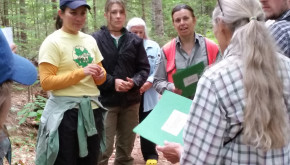
Woodland stewardship is a path of many steps. The storyline often starts with interest, curiosity, and questions about bugs, fire, wood markets, rules and regulations, or current use taxes, just to name a few possible topics. One barrier to getting the information you need to take care of your woods is…who you gonna call?
State forestry agencies are excellent places to start. State Forest Services and Extension offices across the country have foresters dedicated to helping woodland owners. In Maine, your local District Forester provides education, outreach and some technical assistance. In addition, she or he will refer woodland owners to other professionals, including private sector consulting foresters and other service providers. The ultimate goal is to understand what you have in your woods, and develop an idea of what can be done to achieve your vision for them.
In Maine, the initial contact with a District Forester usually entails a walk in the woods and some talk at the kitchen table to answer your questions about your land and help you figure out the next steps. Often, developing a written management plan of some kind is the next thing to do. Finding a consulting forester you are comfortable working with is hopefully the beginning of a long-term relationship with you and your land. Planning is a tool; stewardship is the goal.
Depending on the circumstances, your plan may lead you to a program that helps with costs, and also opens door to further assistance. The WoodsWISE Incentives Program is the Maine brand of the USDA Forest Service’s Forest Stewardship Program. Another, often complementary program is the Environmental Quality Incentives Program, or EQIP. A federal agency called the Natural Resources Conservation Service administers this program directly to woodland owners, via local Soil and Water Conservation Districts. EQIP has money available to help implement practices on the ground.
Besides assistance programs, written forest management plans are a key to current use property tax programs, such as the Tree Growth Tax Law in Maine. Enrolling in this program usually lowers the property tax burden by setting the valuation of managed woodland at a below “fair-market” figure. Note, it is very important to understand the law before enrolling, as there can be substantial penalties for withdrawal. Again, your district forester is an excellent source of information, as are many forestry consultants.
Other potential steps along the stewardship path include some kind of certification, such as joining the American Tree Farm System. Woodland stewardship is often an integral part of estate and legacy planning, as you plan for the future of your land beyond your tenure. Land protection through conservation easement is another possibility; ask your local land trust about working forest easements that allow continued active management in accordance with professional advice and guidance.
For many, the biggest step of all is a timber harvest. Once again, your District Forester is an excellent person to call as you prepare for a harvest. A general rule of thumb: good forester selection leads to good logger selection, which leads to good results in the woods. There is a lot more to say about this, and about the many exciting steps ahead in the stewardship storyline.
- by Andrew Shultz, Maine Forest Service Landowner Outreach Forester

